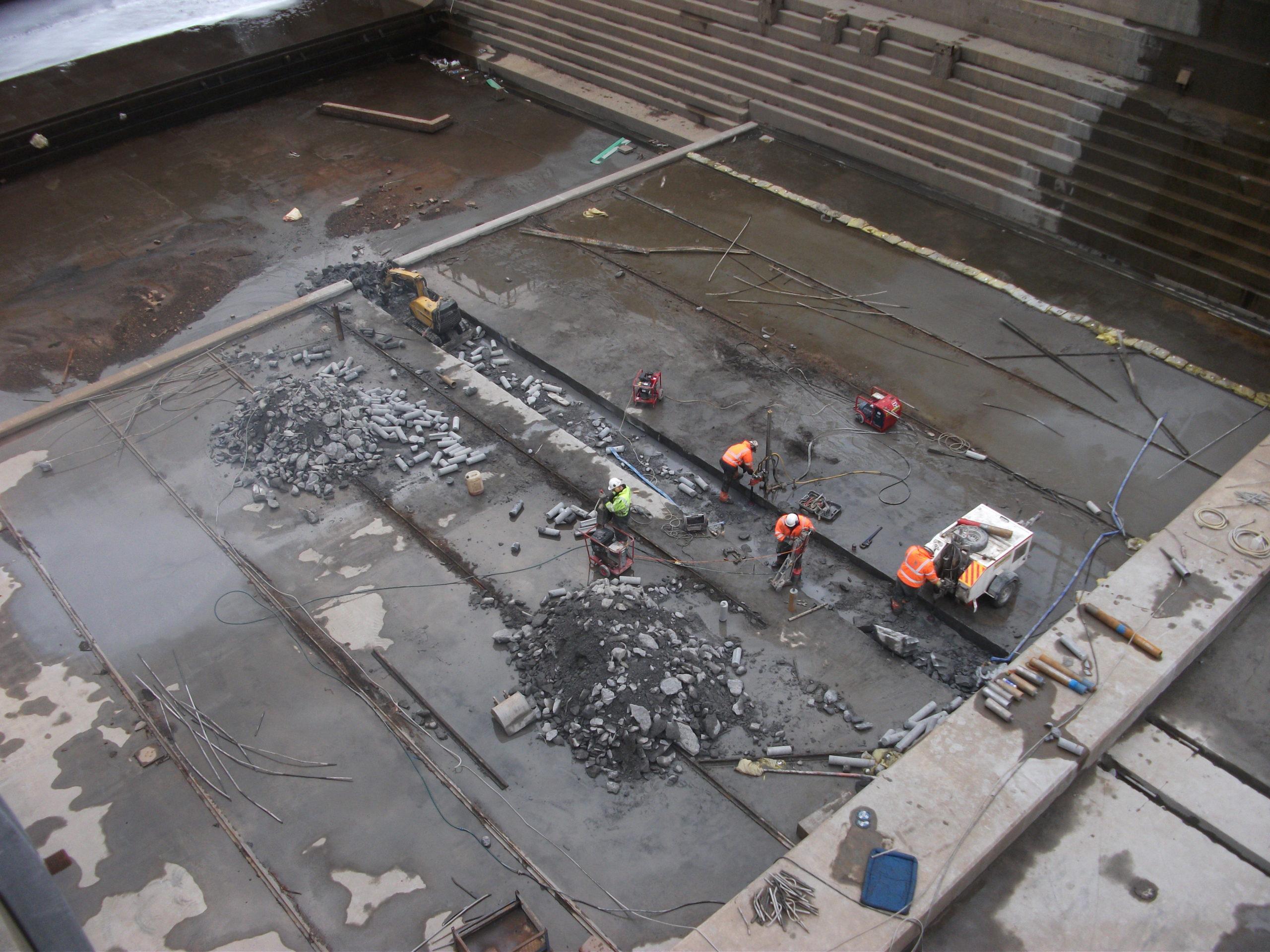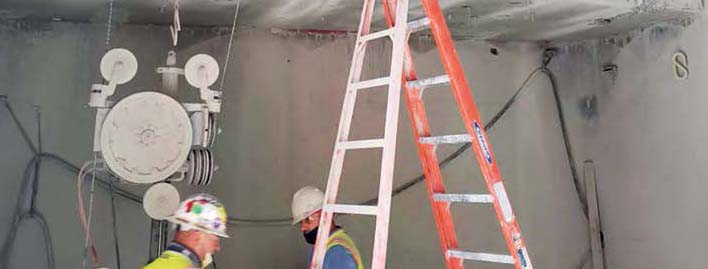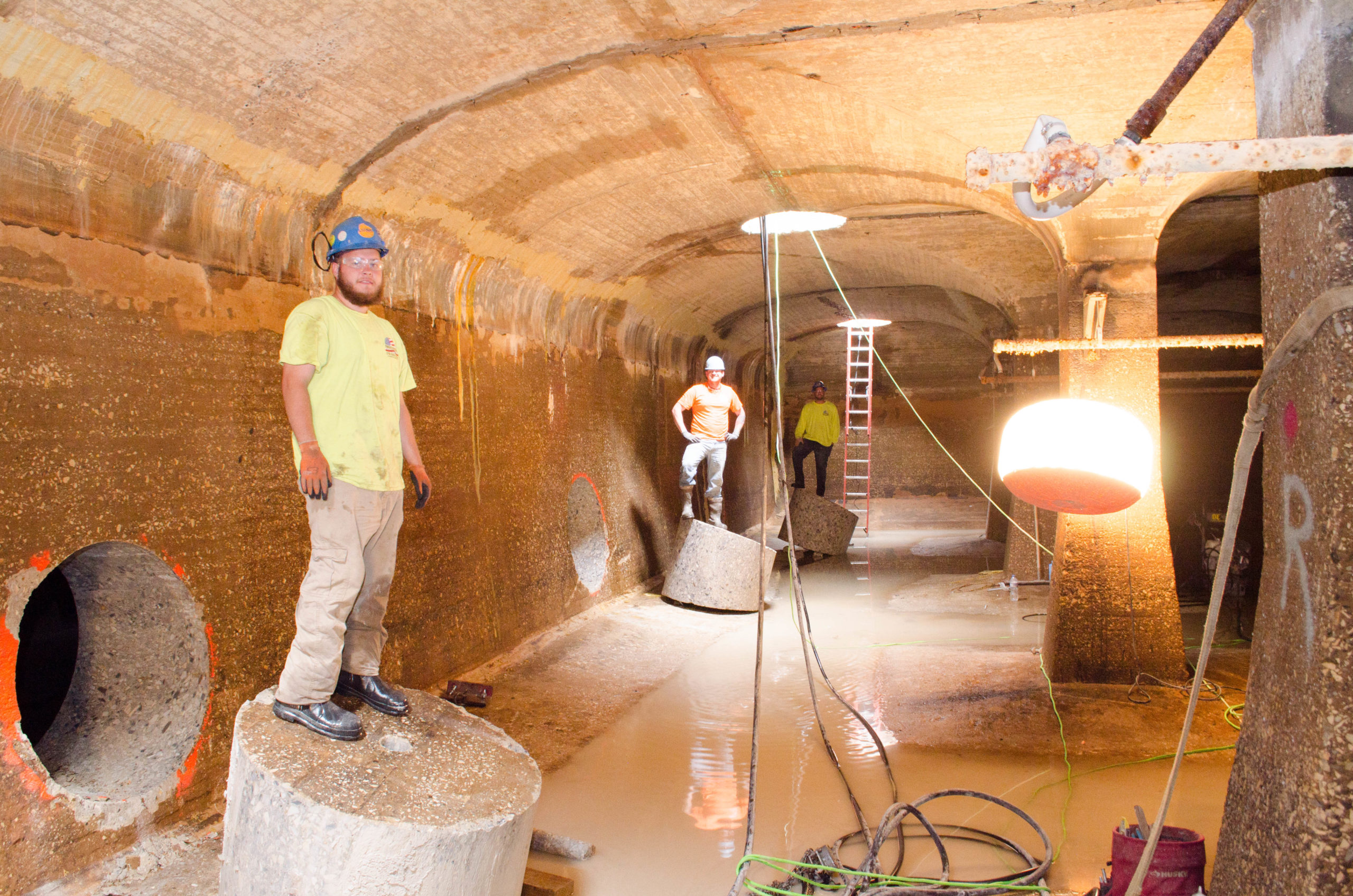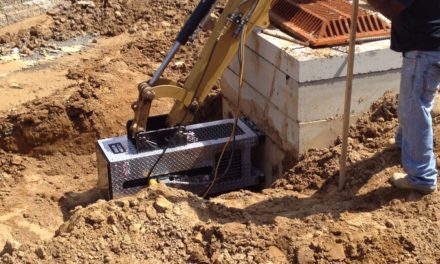
Escape Route

Contractor Creates Safe Passage from Dry Dock
After discovering a dry dock was not living up to its name and retaining approximately 12,000 cubic meters (423,776 cubic feet) of water, a dockyard owner began looking for precise, cost-effective ways to correct the situation. A cutting contractor was chosen to perform sawing, drilling and breaking techniques that helped remove over 350 tons of reinforced concrete and allowed the dock to run dry.
Babcock International, the owner of Rosyth Dockyard in Scotland, United Kingdom, found there was a drainage issue at the yard’s Dry Dock #3. At the bottom of the dock, a concrete seismic sill measuring 44 meters (144 feet) long, 20 meters (66 feet) wide and 1.8 meters (6 feet) tall at its highest point was stopping all water from draining. Therefore, it was proposed that a drainage channel be created in the sill that would give a clear path for water to flow out of the dock.
Cutting and breaking the concrete with diamond tools was considered the only practical method for the work. These techniques provided the speed, efficiency and precision required to form the new drainage channel in a quick and cost-effective way. An alternative method suggested was to use several large excavators to hammer out the concrete and then cut all steel reinforcement, but this was deemed too time-consuming, costly and would have required extensive cleanup.
As concrete sawing and drilling techniques were the preferred method for the work, Babcock contracted CSDA member Holemasters Scotland Limited of Airdrie to create the drainage channel. The contractor has completed a number of projects around the 1,300-acre dockyard over several years [including a core drilling job that was published in our September 2013 issue] so the dock owner was confident this project would be a success.
“We know the site well, but we never take any job at Rosyth for granted,” said David McArthur, project manager for Holemasters. “The job was 20 meters (66 feet) below sea level in a relatively confined area. We had to ensure we used fully-trained crane operators and slingers for the safe positioning of equipment and removal of debris. In addition, a detailed lifting plan had to be written to satisfy the dock owner and we had to secure a qualified first aider for the site.”
The contractor surveyed the site and formulated a plan to create a channel that would run lengthways through the middle of the 44-meter (144-foot) sill measuring 1.8 meters (6 feet) wide and 1.8 meters (6 feet) deep. The first task was to negotiate a layer of 50-millimeter-diameter (2-inch) steel rebar at 200-millimeter (8-inch) centers. Operators made four 44-meter (144-foot) cuts 300 millimeters (11.8 inches) deep in the sill using a Tyrolit diesel-powered flat saw. These cuts were spaced to form two 200-millimeter-wide (7.9-inch) tracks along each side of the channel, with Brokk 90 and 180 demolition robots used to break out the concrete in between the cuts. This part of the job took around 18 days to complete.

Operators used stitch drilling techniques, creating 150-millimeter-diameter (6-inch) holes in the dock sill.
With the tracks and the rebar broken out, it was time to begin stitch drilling. A 150-millimeter-diameter (6-inch) core bit was used along each 200-millimeter-wide (7.9-inch) track to drill a series of holes 1.8 meters (6 feet) deep. This allowed the seismic sill to be split into three sections, with the 1.8-meter-wide (6-foot) middle being removed completely to create the channel. Each hole took an average of one hour to drill and Holemasters had seven operators drilling at the same time using core drill rigs from Hilti and Diamond Products, completing eight holes during an eight-hour shift.
While the majority of the sill was cut using flat saws and core drills, there was one section that required a different method. Running centrally across the width of the sill was a concrete up stand, which had to be removed with a wire saw. The contractor used a Hydrostress saw with a 10-meter (33-foot) length of diamond wire to cut out this section, taking two days to complete. Operators were then able to continue drilling and excavators broke out and removed all cut sections, including the ones created by the wire saw.
As the last few cut sections were removed, the dry dock was partially filled and the new drainage method successfully passed the test. Without this channel, it took approximately 24 hours to drain the dry dock from full, even with the use of pumps. The new system improved drainage time by eight hours, clearing the dry dock of all water in 16 hours. This has increased production on the site because the overall turnaround time of ship repairs has been reduced. The drainage channel has also provided the customer with cost savings by decreasing electrical consumption and reducing pump hire fees, equating to approximately £5,000 ($8,500) of savings every time the dock is emptied.
Over a three-month period, including time for some additional tasks and snag items, Holemasters Scotland completed 1,288 meters (4,226 feet) of core drilling and created 176 linear meters (577 feet) of flat saw cuts before breaking and removing 356 tons of reinforced concrete. All work was completed as budgeted and within the specified time frame.
“We were extremely satisfied with this project, as it proved that we execute large jobs in a safe and efficient manner,” said McArthur. “What was most pleasing, is that we performed so well despite only having a four-day lead time. The success of this job is testament to the hard work and professionalism of our team.”
Dry Dock #3 at Rosyth Dockyard is now back in operation, complete with a new drainage channel. The methods used by this professional concrete cutter provided the necessary escape route for water in the dock and allowed the dock owner to make full use of this area—saving time and money.
Company Profile
Holemasters Scotland Limited has been a CSDA member for three years and is based in Airdie, Scotland, but services the entire United Kingdom. The company has been in business for over 20 years, has 22 operators and 18 vehicles. Holemasters offers the concrete cutting services of core drilling, wall sawing, wire sawing, flat sawing, surface preparation and selective demolition.
Resources
General Contractor:
Babcock International
Sawing and Drilling Contractor:
Holemasters Scotland Limited
Airdrie, Scotland
Phone: +44-845 467 1500
Email: david@holemasters-scotland.co.uk
Website: www.holemasters-scotland.co.uk
Methods Used: Core Drilling, Flat Sawing, Wire Sawing, Selective Demolition















